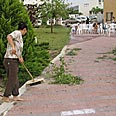
Kibbutzim in 2012: Older, wealthier
Kibbutz movement annual publication reveals that 30%-40% of residents are pensioners, development experiencing slow down and kibbutzim industries sales eroding. So what next for the kibbutz?
The last few years have witnessed a slow down in construction and development of external expansions and today, the majority of new residents are absorbed within the kibbutz.
The year 2012 is something of a challenge for the kibbutzim and especially for the 300 kibbutz industry manufactories. Most of the kibbutzim manufactories operate in traditional industries.
Moreover, following the Kedmi Committee recommendations, customs duties on plastics and food products, which make up 65% of the kibbutzim industry, are set to be decreased; a move which will hurt the profitableness of the industry.
This was evident in the performance of the kibbutzim in 2011. The kibbutzim industry ended the year with total sales worth NIS 40.7 billion ($10.9 billion), an increase of 2.2% compared with the previous year, yet the total operation profit decreased in 2011 by 13.2% to NIS 2.8 billion ($750 million) due to an increase in the prices of raw materials.
Furthermore, the global economic crisis hurt the kibbutzim industries total exports and after an increase of 8.5% in sales between 2009 and 2010, this year saw 0.8% erosion in overseas sales.
Notwithstanding, the kibbutzim industries share in the Israeli market is much larger than its percentage in the Israeli population: 7% of the annual sales returns and 9% of the annual export returns, whereas the kibbutz population stands at 1.6% of Israel's total population.
Over the last few years many kibbutz manufactories have pursued realizations with the purpose of funding increase in funding requirements and credit.
Among the most notable examples, the sale of Kibbutz Yiftah and Kibbutz Magal's holdings in Netafim for NIS 850 million ($227 million) and the sale of Kibbutz Lohamei HaGeta'ot's remaining holdings in Tivol to Osem, for NIS 462 million ($123 million). Today, only half of the kibbutz industries are fully owned by the kibbutzim.
2012 is the last year in which the kibbutzim can pay back their debts in accordance with the settlement signed between the kibbutzim and Bank HaPoalim and Bank Leumi in 1989. Some 160 kibbutzim were included in the settlement – two thirds of the United Kibbutz Movement and the National Kibbutz.
Harsh criticism
An estimated NIS 2 billion ($530 million) in debts were erased, with an additional NIS 1.3 billion ($350 million) debt being erased by the government.
In retrospect, it became clear that determined repayment power was unrealistic and that the kibbutzim were once again in heavy debt, which led the State to agree on a new settlement in 1996 through which kibbutz land was recognized as saleable real estate worth NIS 8 billion ($2.14 billion) in order to allow the kibbutzim to repay their debts. Some of the lands were given back to the Israel Land Administration.
The new settlement prompted harsh public criticism at both the kibbutzim and the government, who used the State budget to extricate the kibbutzim from the economic troubles they got themselves into.
Yet the settlement's supporters said that the damages that the kibbutzim crisis would have created for Israel's economy as well as periphery communities if the kibbutzim were to collapse would have been infinitely greater than the cost of the settlement.
Funds for infrastructure
Omri Cnaan, head of the kibbutz management department at the Kibbutz Movement, told Calcalist that "this is a very significant issue. The kibbutzim have projects that have without a doubt been hurt over the years due to commitments to the banks. For example, infrastructure projects, this is an average investment of NIS 20-30 million ($5.3-8 million) for each kibbutz.
"The completion of the kibbutzim settlement agreement means that each kibbutz will now have additional funds released for these kinds (infrastructure) of projects. As well as increasing pensions and investment in the community."
Nevertheless, in 2013 there 10 kibbutzim that have extended the settlement agreement with the banks, or who have reached an additional agreement with the banks, will be continuing to pay their debts through to the year 2025.
Dotan Levy contributed to the report










